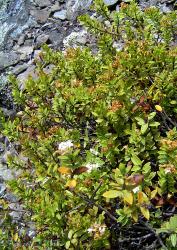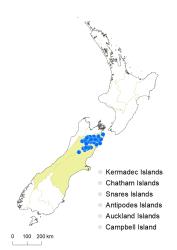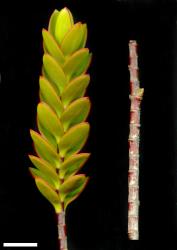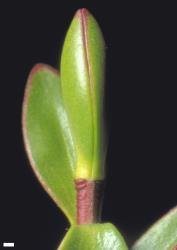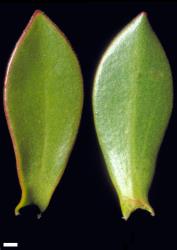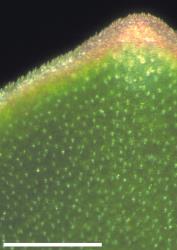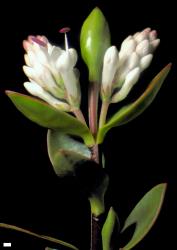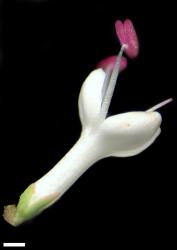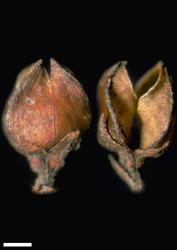- ≡ Hebe decumbens (J.B.Armstr.) Cockayne & Allan, Trans. New Zealand Inst. 57: 34 (1926)
Low shrub to 0.35 m tall. Stems usually decumbent to ascending, sometimes erect; pubescence usually bifarious, rarely uniform, eglandular. Leaf bud distinct, its leaves appressed at margins until fully grown; sinus absent. Leaves opposite-decussate, erecto-patent; lamina coriaceous, elliptic to broadly elliptic, or oblanceolate to obovate, 6.5–23.5 mm long, 2–13 mm wide, glossy yellowish- or bronze-green above and beneath; midrib evident and 2 lateral veins sometimes visible; surfaces glabrous; margin glabrous or with very short, stiff, tapering eglandular and sometimes glandular hairs, entire, usually red or sometimes yellowish; apex sub-acute to acute; base cuneate; petiole indistinct 1–2 mm long. Inflorescence a lateral spike or raceme, 6–30 mm long; flowers crowded, 2–25, all bisexual; bracts alternate or sometimes the lowermost opposite or a whorl of 3, narrowly deltoid or sometimes ovate, > pedicels; pedicels erecto-patent, 0.2–1.7 mm long, with very short, glandular and eglandular hairs all around. Calyx lobes 4–5 (5th small, posterior), acute to acuminate or obtuse, 1.0–1.5 mm long, sub-equal, mixed glandular- and eglandular-ciliolate, surface with scattered, minute, sessile, glandular hairs or glabrous. Corolla 6–7 mm diameter; tube white, 3–6 mm long, > calyx, glabrous; lobes 4, white, sub-erect to spreading, unequal, elliptic to ovate, 2–3 mm long, obtuse to rounded; nectar guides absent. Stamen filaments white, 4.2–7.0 mm long; anthers magenta or purplish. Style glabrous, 6–11 mm long. Capsules latiseptate, sub-acute, glabrous, 2.5–5.5 mm long, 2–3.5 mm at widest point. Seeds ovoid to oblong, flattened, very finely papillate, brown, 1.0–1.7 mm long.
Veronica decumbens is a distinctive hebe, characterised by green to bronze-green leaves with very short, tapered, stiff hairs on the usually red margins, dark red-brown to almost black stems, very long, slender, and slightly curved corolla tubes, and short, compact inflorescences with sessile to sub-sessile flowers. Dry specimens often have very dark, almost black, leaves and then can be mistaken for V. pinguifolia. V. pinguifolia plants differ in their glaucous leaves, shorter corolla tube (2–3 mm long), hairy capsule and style base, and opposite flowers.
South Island: Marlborough, Canterbury (north of Waiau River), Westland (north and east of Mātakitaki River valley).
Grassland and low shrubland, often in open and stony sites. Recorded elevations range from 600 to 1538 m.
Flowers: November–February; fruits: January–May, persisting all year.
2n = 40 (see Bayly & Kellow 2006, as Hebe decumbens).
Veronica decumbens is classified in V. subg. Pseudoveronica sect. Hebe and the informal group “Occlusae” (Albach & Meudt 2010; Bayly & Kellow 2006).
Brian Molloy (pers. comm., 27 Jan. 1992) observed black scree butterflies visiting the flowers of V. decumbens at Hanmer Springs.



